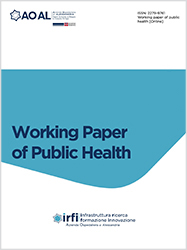Feasibility of a questionnaire on asbestos awareness among students: a pilot study

Accepted: 2 August 2023
All claims expressed in this article are solely those of the authors and do not necessarily represent those of their affiliated organizations, or those of the publisher, the editors and the reviewers. Any product that may be evaluated in this article or claim that may be made by its manufacturer is not guaranteed or endorsed by the publisher.
Background: there is no resolutive treatment for asbestos-related diseases, but prevention plays a key role. This survey was conducted to test the feasibility of a questionnaire to measure the awareness on asbestos among the students in a specific asbestos polluted area. Furthermore, we carried out a preliminary assessment of student awareness on this topic. Methods: a questionnaire was used among secondary school students of Casale Monferrato. This considered the levels of sensitivity, knowledge, and experienced emotions. Results: 788 students completed the questionnaire out of a total of 3600 (22.2%). Thirty-five percent of the students were poorly informed about the asbestos issue, 26% felt that they had basic information on this topic. Twelve percent of the students thought that asbestos is no longer a problem. Conclusions: it emerges the strong need to become more knowledgeable on asbestos’ history. A questionnaire is a useful tool, but structural changes are needed to facilitate the analysis of the results.
Hickey J, Saunders J, Davern P. The extent and influence of Asbestos Safety Awareness training among managers who had previously commissioned an asbestos survey in their workplace buildings. Ind Health. 2015;53:398-409. DOI: https://doi.org/10.2486/indhealth.2014-0162
Solbes E, Harper RW. Biological responses to asbestos inhalation and pathogenesis of asbestos-related benign and malignant disease. J Investig Med. 2018;66:721-7.
Italian Parliament Law n. 257, 27 March 1992. Norms regarding the discontinuance of the utilization of asbestos. Italian Official Journal n. 64, 13 April 1992.
Campopiano A, Cannizzaro A, Olori A, et al. Asbestos containing materials in schools of Rome and surrounding area (Italy). Industrial Health. 2021;59:436-48. DOI: https://doi.org/10.2486/indhealth.2021-0036
Marsili D, Angelini A, Bruno C, et al. Asbestos Ban in Italy: A Major Milestone, Not the Final Cut. International journal of environmental research and public health. 2017;14:1379. DOI: https://doi.org/10.3390/ijerph14111379
Solbes E, Harper RW. Biological responses to asbestos inhalation and pathogenesis of asbestos-related benign and malignant disease. J Investig Med. 2018;66:721-7. DOI: https://doi.org/10.1136/jim-2017-000628
Musk AW, de Klerk N, Reid A, et al. Asbestos-related diseases. Int J Tuberc Lung Dis. 2020;24:562-7. DOI: https://doi.org/10.5588/ijtld.19.0645
Broaddus VC, Everitt JI, Black B, et al. Non-neoplastic and neoplastic pleural endpoints following fiber exposure. J Toxicol Environ Health B Crit Rev. 2011;14:153-78. DOI: https://doi.org/10.1080/10937404.2011.556049
Marsili D, Terracini B, Santana VS, et al. Prevention of Asbestos-Related Disease in Countries Currently Using Asbestos. Int J Environ Res Public Health. 2016;13:494. DOI: https://doi.org/10.3390/ijerph13050494
Comba P, D'Angelo M, Fazzo L, et al. Mesothelioma in Italy: the Casale Monferrato model to a national epidemiological surveillance system. Ann Ist Super Sanita. 2018;54:139-48.
Copyright (c) 2023 Adriana Canepa, Carlo Degiacomi, Maria Cristina Portinaro, Grazia Gatti, Stefania Crivellari, Carlotta Bertolina, Marianna Farotto, Melissa Pozzi, Leonardo Deambrogio, Riccardo Belvisotti, Marinella Bertolotti, Antonio Maconi

This work is licensed under a Creative Commons Attribution-NonCommercial 4.0 International License.
PAGEPress has chosen to apply the Creative Commons Attribution NonCommercial 4.0 International License (CC BY-NC 4.0) to all manuscripts to be published.

 https://doi.org/10.4081/wpph.2023.9783
https://doi.org/10.4081/wpph.2023.9783




